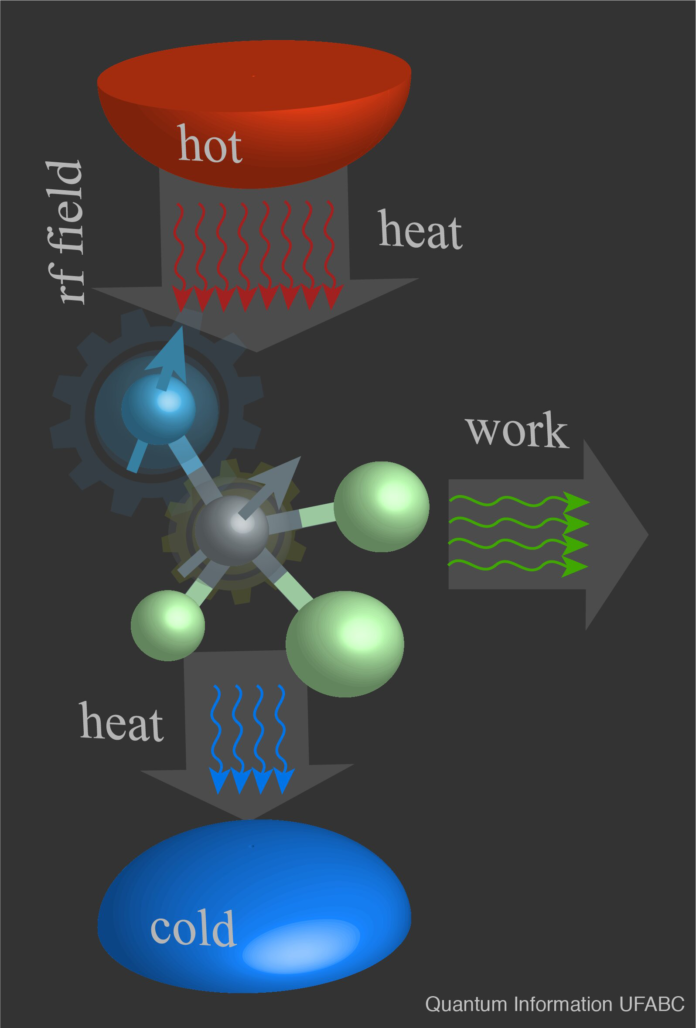The hypothetical idea of a ‘quantum heat engine’ has been around for quite a few years. First introduced six decades ago, the analogy was brewed between three-level masers and thermal machines.
In the following years, various scientists have developed a variety of theories, presenting recommendations for thermodynamic cycles at the quantum scale. Recently, physicists have begun testing some of these theories in experimental settings.
One of these experiments was carried out by a team of researchers at the University of Waterloo, Universidade Federal do ABC, and Centro Brasileiro de Pesquisas Físicas. They demonstrated a spin quantum heat engine in a laboratory setting.
Roberto Serra, one of the researchers who carried out the study, said, “The so-called ‘quantum thermodynamics’ is currently under development. This emerging field is also associated with events in quantum technology, which promises a kind of new industrial revolution at the nanoscale with disruptive devices for computation, communication, sensors, etc.”
During the experiment, scientists actualized a proof-of-principle quantum heat engine utilizing a nuclear spin placed in a chloroform molecule and nuclear magnetic resonance strategies. The analysts explicitly controlled the atomic spin of a Carbon 13 isotope using a radiofrequency field, eventually creating an Otto cycle.
The energy distinction between the two possible nuclear spin states was increased and decreased like a piston works in a car engine. Under certain conditions, the nuclear spins in the particle can ingest and discharge heat from/to radio waves.
In the quantum scenario, energy fluctuations play a vital role, and that’s what scientists focused on. Estimating these changes in a thermodynamic cycle, notwithstanding, is an extremely challenging task. Scientists found that when performing a quantum Otto cycle powerfully, their quantum heat engine could accomplish effectiveness for work extraction of η≈42%, which is near its thermodynamic limit (η=44%).
John Peterson, one of the co-authors of the study, said, “In the present experiment, we were able to characterize all energy fluctuations in work and heat, besides the irreversibility at the quantum scale. Fast operation of our molecular machine produces transitions between the spin energy states, which are related to what we call ‘quantum friction’ that reduces performance. This kind of friction is also associated with an increase in entropy. On the other hand, a prolonged operation (that decreases quantum friction) will not deliver a considerable amount of extracted power. So, the best scenario is to conciliate some amount of power with low levels of quantum friction or entropy production in a similar way to what modern engineering does in cars’ engines.”
Roberto Serra, one of the researchers who carried out the study, said, “In our experiment, the tiny spin engine reaches an efficiency close to its thermodynamic limit at maximum power, which is much better than what car engines can do nowadays. The quantum spin engine would not be very useful in practice since the work produced would supply a very small amount of energy to radio waves. It would only be sufficient to alter another nuclear spin. We are more interested in measuring how much energy it uses, how much heat it dissipates, and how much entropy is produced during operation.”
Scientists further want to identify ways to optimize the operation of small quantum thermal machines, demonstrating their effectiveness in real experiments. This could ultimately help to build more advanced quantum refrigerators that could be implemented in new quantum computers.
Their paper is published in Physics Review Letters.
